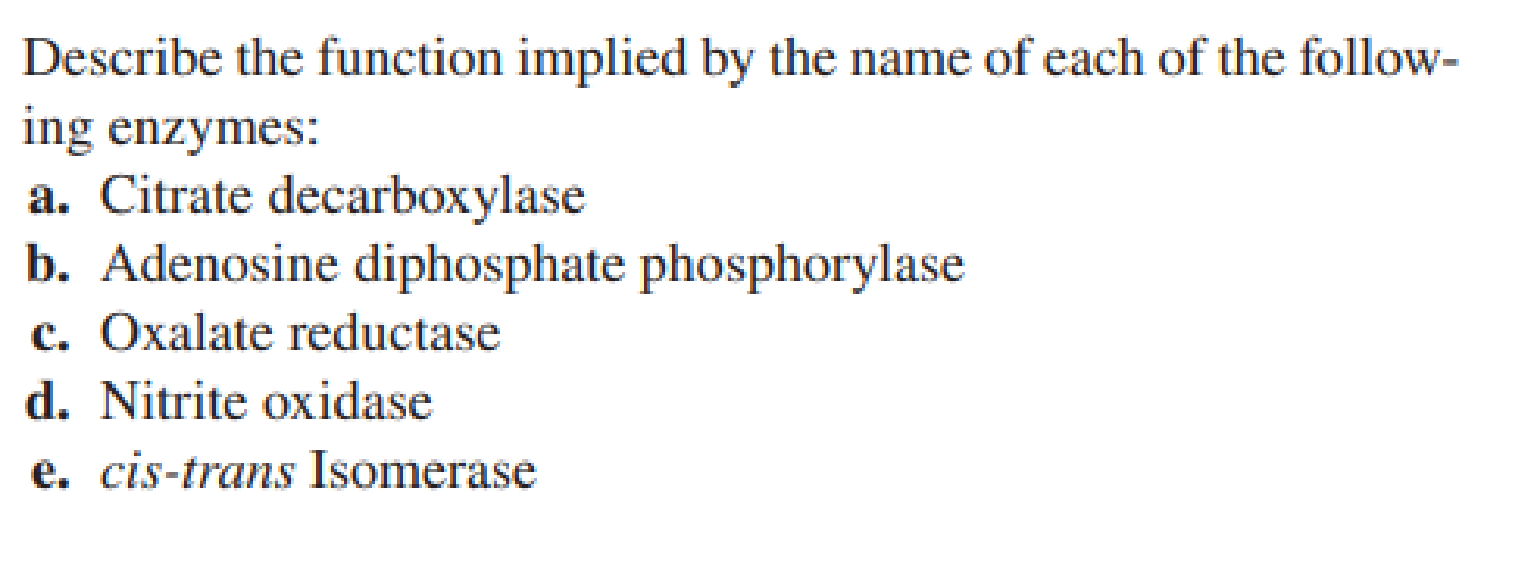
Concept explainers
(a)
Interpretation:

The function implied by the enzyme citrate decarboxylase has to be given.
Concept Introduction:
The enzymes are essentially the biocatalysts present in all living systems. Each enzyme catalyzes a characteristic reaction within the biological system. Enzymes on the basis of the substrate on which they act or the reaction that they catalyze can be classified into six classes.
Based on their specific role they are classified into six major classes. These are:
- Ligases: The enzymes that connect two molecules via covalent bonds are termed as ligases.
- Isomerases: The enzymes that catalyze the isomerization reactions are termed as isomerases.
- Lyases: Enzymes that catalyze the cleavage of bonds are called lyases.
- Hydrolases: These enzymes catalyze the cleavage of bonds via hydrolysis present in biological systems.
- Transferases: These enzymes are involved in the transfer of various
functional groups such as methyl, acetyl group, or phosphate group. - Oxidoreductases: As the name suggests, these catalyze the
oxidation and reduction reactions that occur in living systems.
Enzymes are often named in accordance with the substrate on which they act. For example, lactase acts on the disaccharide named lactose and helps to remove the glycosidic linkages of lactose.
(b)
Interpretation:
The function implied by the enzyme adenosine diphosphate phosphorylase has to be given.
Concept Introduction:
Refer to part (a).
(c)
Interpretation:
The function implied by enzyme oxalate reductase has to be given.
Concept Introduction:
Refer to part (a).
(d)
Interpretation:
The function implied by the enzyme nitrite oxidase has to be given.
Concept Introduction:
Refer to part (a).
(e)
Interpretation:
The function implied by the enzyme cis-trans isomerase has to be given.
Concept Introduction:
Refer to part (a).
Want to see the full answer?
Check out a sample textbook solution
Chapter 19 Solutions
General, Organic, and Biochemistry
- What is the product of the reaction? F3C. CF3 OMe NaOH / H₂Oarrow_forwardWhat would you expect to be the major product obtained from the following reaction? Please explain what is happening here. Provide a detailed explanation and a drawing showing how the reaction occurs. The correct answer to this question is V.arrow_forwardPlease answer the question for the reactions, thank youarrow_forward
- What is the product of the following reaction? Please include a detailed explanation of what is happening in this question. Include a drawing showing how the reagent is reacting with the catalyst to produce the correct product. The correct answer is IV.arrow_forwardPlease complete the reactions, thank youarrow_forwardConsider the synthesis. What is compound Y? Please explain what is happening in this question. Provide a detailed explanation and a drawing to show how the compound Y creates the product. The correct answer is D.arrow_forward
- What would be the major product of the following reaction? Please include a detailed explanation of what is happening in this question. Include steps and a drawing to show this reaction proceeds and how the final product is formed. The correct answer is B. I put answer D and I don't really understand what is going on in the question.arrow_forwardWhat is the product of the following reaction? Please explain what is happening in this question. Provide a detailed explanation and a drawing showing how the reagent is reacting with the catalysts to product the correct product. The correct answer is B.arrow_forwardWhat is the missing intermediate 1 and the final product 2. Please include a detailed explanation explaining the steps of malonic ester synthesis. Please include drawings of the intermediate and how it occurs and how the final product is former.arrow_forward
 ChemistryChemistryISBN:9781305957404Author:Steven S. Zumdahl, Susan A. Zumdahl, Donald J. DeCostePublisher:Cengage Learning
ChemistryChemistryISBN:9781305957404Author:Steven S. Zumdahl, Susan A. Zumdahl, Donald J. DeCostePublisher:Cengage Learning ChemistryChemistryISBN:9781259911156Author:Raymond Chang Dr., Jason Overby ProfessorPublisher:McGraw-Hill Education
ChemistryChemistryISBN:9781259911156Author:Raymond Chang Dr., Jason Overby ProfessorPublisher:McGraw-Hill Education Principles of Instrumental AnalysisChemistryISBN:9781305577213Author:Douglas A. Skoog, F. James Holler, Stanley R. CrouchPublisher:Cengage Learning
Principles of Instrumental AnalysisChemistryISBN:9781305577213Author:Douglas A. Skoog, F. James Holler, Stanley R. CrouchPublisher:Cengage Learning Organic ChemistryChemistryISBN:9780078021558Author:Janice Gorzynski Smith Dr.Publisher:McGraw-Hill Education
Organic ChemistryChemistryISBN:9780078021558Author:Janice Gorzynski Smith Dr.Publisher:McGraw-Hill Education Chemistry: Principles and ReactionsChemistryISBN:9781305079373Author:William L. Masterton, Cecile N. HurleyPublisher:Cengage Learning
Chemistry: Principles and ReactionsChemistryISBN:9781305079373Author:William L. Masterton, Cecile N. HurleyPublisher:Cengage Learning Elementary Principles of Chemical Processes, Bind...ChemistryISBN:9781118431221Author:Richard M. Felder, Ronald W. Rousseau, Lisa G. BullardPublisher:WILEY
Elementary Principles of Chemical Processes, Bind...ChemistryISBN:9781118431221Author:Richard M. Felder, Ronald W. Rousseau, Lisa G. BullardPublisher:WILEY





